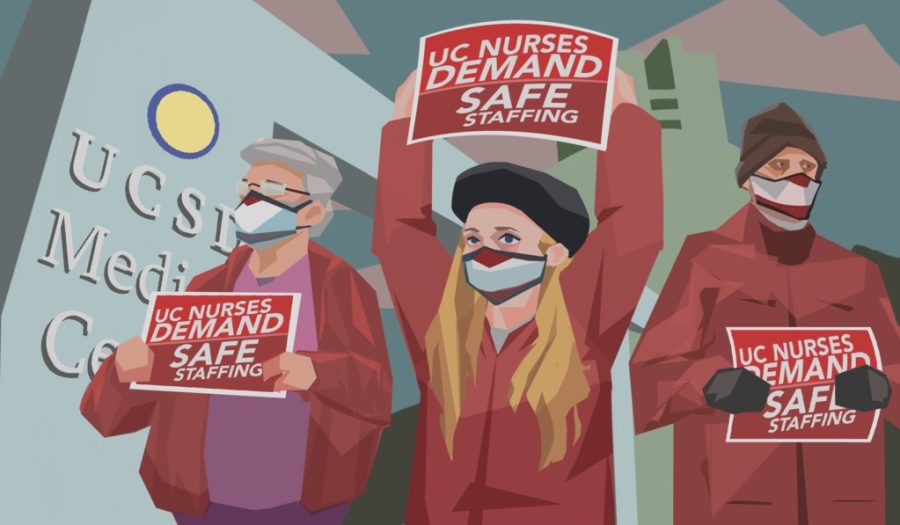UC San Diego nurses demanded changes in staffing for safe patient care throughout the University of California system during a press conference on Jan. 27 at the UCSD Medical Center in Hillcrest. This demand came amidst growing concerns about the state of intensive care unit capacities after the regional stay-at-home order for Southern California was lifted on Jan. 25.
As cases are expected to rise once again with COVID-19 restrictions loosening, nurses are concerned about how this will affect nurse to staffing ratios in hospital units. With the passage of A.B. 394 in 1999, California is the only state in the nation that has specific registered nurse to patient ratios by law. The law requires California’s Department of Public Health to establish specific numerical ratios for specific hospital units.
However, these safe staffing standards were rolled back in December of last year when many hospitals across the country were increasingly overwhelmed with COVID-19 cases. Hospitals were offered the option of applying for a temporary expedited waiver from the California Department of Public Health to waive the staffing ratio, forcing nurses to care for more patients than was previously permitted by law.
In an interview with The UCSD Guardian, Shannon Cotton, a registered nurse in the COVID-19 ICU unit at the UCSD Medical Center in Hillcrest said that nurse to patient staffing ratios help to keep patients safe as they ensure that patients are properly cared for. The granting of the expedited waivers poses a dangerous risk for both nurses and patients.
“Nurses fought, in California, for a long time, for our landmark law creating nurse to patient ratios, which means in different units, there is a maximum number of patients you can take care of,” Cotton said. “For example, in the [intensive care unit] where I work, I can only take care of two patients during a shift because those patients need my complete attention, they have extreme amounts of drips, they can turn a corner for the worse any second. I can always take care of less, I can be what we call a one to one or a one to two, where two nurses have to take care of the patient, but I can never take care of three, four, five patients at a time.”
On Feb. 1, the law was put back in place when the CDPH announced that they would no longer be accepting any new expedited staffing waivers, and the existing approved waivers are set to expire on Feb. 8. Furthermore, hospitals must maintain efforts to meet required staffing levels at all times and will be subject to investigation by the CDPH if they are suspected not to.
According to a press release by the California Nurses Association, this decision came only after several protests and direct action by nurses.
“Nurses have staged hundreds of direct actions inside and outside their hospitals in defense of safe staffing standards, including a mass mobilization most recently on Jan. 27; held statewide as well as hospital chain-wide press conferences for media; and sent almost 6,000 emails in protest to CDPH,” the press release said.
When asked about her thoughts on how the stopping of expedited staffing waivers will impact ICU capacities in the midst of the ongoing pandemic, Cotton emphasized personal responsibility and community support.
“It’s kind of a double-edged sword, you don’t want your ratios to be broken for safety, but also you care about your community, the economy. Our communities are suffering in other ways right now because of the lockdown. As a nurse, I do believe that we have to take all of the precautions when we’re going outside, when we’re going to meet others who aren’t in our families, wearing masks, socially distancing and staying home when you can. We can’t rebuild our economy if the people in our communities are sick, dying or dead. I think we need to continue the lockdown until we actually see COVID numbers decreasing and our mortality and morbidity rates decreasing.”
Cotton also highlighted the urgent need for widespread vaccination of underprivileged and underserved communities who historically do not have access or trust in the healthcare system, and that more people need to be vaccinated before the state can safely reopen.
As of Feb. 6, San Diego County remains at the purple tier, the most restrictive tier in California’s color-coded tier system. While this means that many non-essential indoor business operations are still closed, many operations, like restaurants with outdoor seating areas and personal care services are opening back up. Retail, shopping centers, and places of worship can still only operate at 25 percent capacity, and many gyms, movie theaters, and entertainment centers are restricted to outdoor activities only.
In a statement provided to The Guardian, UCSD Health maintains that patient care has been and remains their top priority. It also states that they have not and currently do not plan to apply for a staffing ratio waiver.
“UC San Diego Health has maintained appropriate and safe staffing ratios throughout the pandemic. We recognize that extreme situations elsewhere have prompted other health care facilities to seek additional tools to continue safe, effective care of their patients,” the statement read. “However, UC San Diego Health has not applied for a staffing ratio waiver, and with the partnership of our community to remain masked and maintain social distancing practices, we hope to get through the pandemic without applying for this option.”
UCSD Health also emphasized on the reliance of vaccines to keep healthcare workers and the community safe.
“At UC San Diego Health, we have invited 100 percent of our health care workers to be vaccinated. More than 10,000 employees have received their first dose and more than 6,000 have received their second dose,” the statement said. “Moreover, in partnership with the County of San Diego and others, we have vaccinated to date more than 57,000 community members at the Petco Vaccination Super Station.”
From Jan. 8 to Feb. 6, there was a 20 percent decrease in the number of COVID-19 confirmed ICU patients in San Diego County hospital. As of Feb. 7, ICU capacity is at 18 percent while general hospital capacity is at 78 percent.
Artwork courtesy of Nicholas Regli for The UCSD Guardian.














